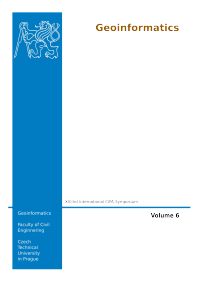3DMADMAC|AUTOMATED: synergistic hardware and software solution for automated 3D digitization of cultural heritage objects
DOI:
https://doi.org/10.14311/gi.6.40Keywords:
3D shape measurement, structured light, next best view, cultural heritage 3D digitization, automated data processingAbstract
In this article a fully automated 3D shape measurement system and data processing algorithms are presented. Main purpose of this system is to automatically (without any user intervention) and rapidly (at least ten times faster than manual measurement) digitize whole object’s surface with some limitations to its properties: maximum measurement volume is described as a cylinder with 2,8m height and 0,6m radius, maximum object's weight is 2 tons. Measurement head is automatically calibrated by the system for chosen working volume (from 120mm x 80mm x 60mm and ends up to 1,2m x 0,8m x 0,6m). Positioning of measurement head in relation to measured object is realized by computer-controlled manipulator. The system is equipped with two independent collision detection modules to prevent damaging measured object with moving sensor’s head. Measurement process is divided into three steps. First step is used for locating any part of object’s surface in assumed measurement volume. Second step is related to calculation of "next best view" position of measurement head on the base of existing 3D scans. Finally small holes in measured 3D surface are detected and measured. All 3D data processing (filtering, ICP based fitting and final views integration) is performed automatically. Final 3D model is created on the base of user specified parameters like accuracy of surface representation and/or density of surface sampling. In the last section of the paper, exemplary measurement result of two objects: biscuit (from the collection of Museum Palace at Wilanów) and Roman votive altar (Lower Moesia, II-III AD) are presented.References
Google Art Project, http://www.googleartproject.com/.
Grand Versailles Numérique, http://www.gvn.chateauversailles.fr.
The Khufu Pyramid, http://www.3dvia.com/3d_experiences/view_experience.php?experienceId=1.
J. Iwaszkiewicz's Stawisko, http://stawisko.pl/wirtualne/stawisko/index.html.
F. Chopin's Piano, http://www.culture.pl/chopin/index.html.
E. Bunsch, R. Sitnik, J. Michoński, Art documentation quality in function of 3D scanning resolution and precision, Proc. SPIE 7869, 2011, 78690D.
E. Bunsch, R. Sitnik, Documentation instead of visualization - applications of 3D scanning in works of art analysis, Proc. SPIE 7531, 2010, 75310I.
Dorai, C., Wang, G., Jain, A.K., Mercer, C.: Registration and integration of multiple object views for 3D model construction, IEEE Transactions on Pattern Analysis and Machine Intelligence, 20 (1998) 1.
Zhou, H., Liu Y.: Accurate integration of multi-view range images using k-means clustering, Pattern Recognition, 41 (2008) 1, 152-175.
Kapoutsis, C.A., Vavoulidis, C.P., Pitas, I.: Morphological iterative closest point algorithm, IEEE Transactions on Image Processing, 8 (1999) 11, 1644 – 1646.
Zach, C., Pock, T., Bischof, H.: A Globally Optimal Algorithm for Robust TV-L1 Range Image Integration, IEEE 11th International Conference on Computer Vision, October 2007, 1 - 8.
Sappa, A. D., García, M.A.: Incremental Multiview Integration of Range Image, 15th IAPR International Conference on Pattern Recognition, Barcelona, September 2000, 546-549.
Ainsworth, I., Ristic, M., Brujic D.: CAD-Based Measurement Path Planning for Free-Form Shapes Using Contact Probes, International Journal of Advanced Manufacturing Technology, (2000) 16, 23–31.
Thrun, S.: Robotic mapping: A survey, Exploring Artificial Intelligence in the New Millenium San Mateo, CA, Morgan Kaufmann, 2002.
Gamini Dissanayake, M. W. M., Newman, P., Clark, S., Durrant-Whyte, H. F., Csorba, M.: A Solution to the Simultaneous Localization and Map Building (SLAM) Problem, Transactions on Robotics and Automation, 17 (2001) 3.
Menegatti, E., Pretto, A., Scarpa, A., Pagello, E.: Omnidirectional Vision Scan Matching for Robot Localization in Dynamic Environments, IEEE Transactions on Robotics, 22 (2006) 3.
Chang, H., J., Lee, , C. S. G., Lu, Y-H., Hu, Y.C.: P-SLAM: Simultaneous Localization and Mapping With Environmental-Structure Prediction, IEEE Transactions on Robotics, 23 (2007) 2.
Besl, P., McKay, N.: A method for Registration of 3-D Shapes, IEEE Transactions on Pattern Analysis and Machine Intelligence, 14(1992)2, 239 – 256.
Sitnik ,R., Kujawińska, M., Załuski, W.: 3DMADMAC system: optical 3D shape acquisition and processing path for VR applications, Proc. SPIE 5857, 2005, 106-117.
Szelegejd, B.: Wyrafinowany urok białej porcelany. Wilanowska kolekcja biskwitów, Warsaw 2006, 71-72.
Downloads
Published
Issue
Section
License
- Authors retain copyright and grant the journal right of first publication with the work simultaneously licensed under a Creative Commons Attribution License that allows others to share the work with an acknowledgement of the work's authorship and initial publication in this journal.
- Authors are able to enter into separate, additional contractual arrangements for the non-exclusive distribution of the journal's published version of the work (e.g., post it to an institutional repository or publish it in a book), with an acknowledgement of its initial publication in this journal.
- Authors are permitted and encouraged to post their work online (e.g., in institutional repositories or on their website) prior to and during the submission process, as it can lead to productive exchanges, as well as earlier and greater citation of published work (See The Effect of Open Access).

